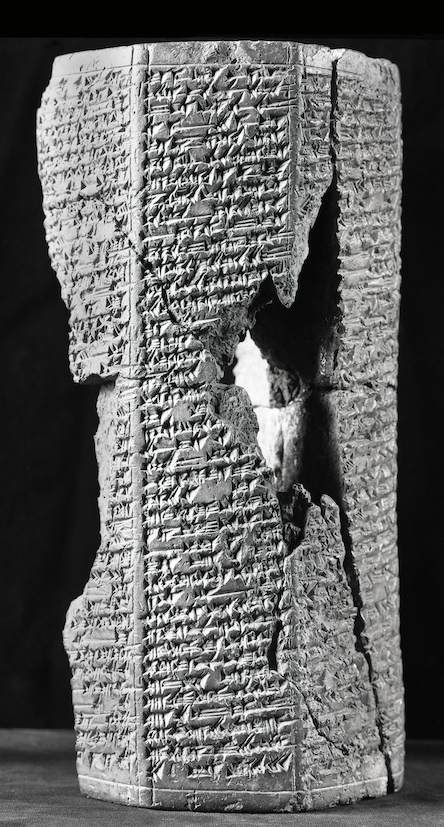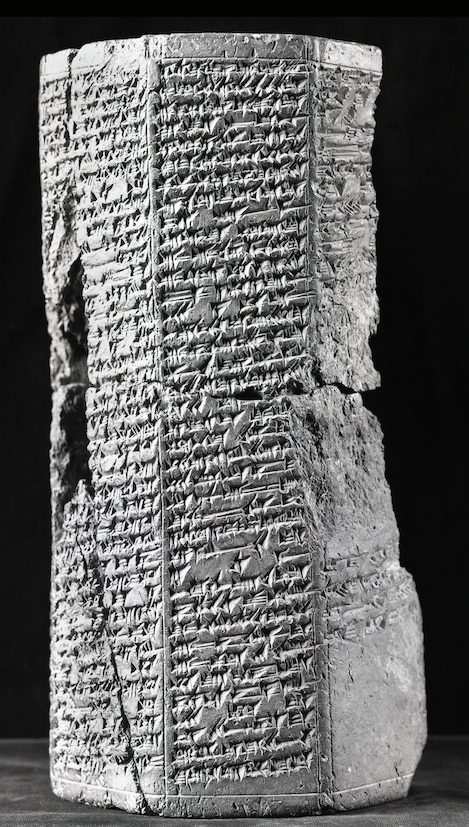Aššur, Part 1
57 58 59 60 61 62 63 64 65 66 67
57 [/rinap/rinap4/Q003286/]
An Akkadian inscription on seven octagonal prisms, a stone tablet, and a clay tablet from Aššur describes the rebuilding of Ešarra, the temple of the god Aššur in Aššur. The text contains a history of the previous building work done on the temple by Esarhaddon's predecessors (Ušpia, Erišum I, Šamšī-Adad I, and Shalmaneser I) and gives the number of years between each renovation. Two copies are dated to 679 BC, during the months Simānu (III) and Duʾūzu (IV). This text is commonly referred to as Aššur A (Ass. A).
Access the composite text [/rinap/rinap4/Q003286/] or the score [/rinap/scores/Q003286/score] of Esarhaddon 57
Sources [/rinap/scores/Q003286/sources]:
| (1) VA 08411 + VA 10130 (+) UM 32–22–005 [/rinap/sources/P257223/] (Ass 12260) | (2) VA 07513 [/rinap/sources/P450433/] (Ass 01783) | (3) VA 07504 [/rinap/sources/P450434/] |
| (4) VA 08428 [/rinap/sources/P450435/] | (5) Ass 018231a+b [/rinap/sources/P450436/] | (6) VAT 09642 + VAT 11095 + VAT 11682 [/rinap/sources/P450437/] |
| (7) VA 05935 [/rinap/sources/P450438/] (Ass 16123) | (8) VA Ass 04719 [/rinap/sources/P450439/] (Ass 19525) | (9) VA 07507 [/rinap/sources/P450440/] (Ass 01532) |
Commentary
Exs. 1–4 and 7–9 are octagonal prisms, ex. 5 is a stone tablet, and ex. 6 is a clay tablet. All of the sources except UM 32–22–5 were excavated at Aššur. Two of the fragments that make up ex. 6 were joined by R. Borger (HKL 2 p. 18; VAT 9642 + VAT 11095), and the third piece (VAT 11682) was identified by S. Maul and joined to the others by E. Frahm. Exs. 7–8 were not available for study and have not been incorporated into the score. Ex. 9 was identified by E. Frahm as a duplicate of this text with the help of photographs provided by S. Maul; we were able to include this prism thanks to the generosity of E. Frahm.
With regard to the time-spans, "Distanzangaben," in Assyrian texts, see most recently Ch. Eder, "Assyrische Distanzangaben und die absolute Chronologie Vorderasiens," AoF 31 (2004) pp. 191–236; and R. Pruzsinszky, "Zum Verständnis der assyrischen Distanzangaben: Beiträge zur assyrischen Chronologie," SAAB 14 (2002–2005) pp. 23–31.

UM 32-22-5 cols. iv–vi (text no. 57 ex. 1), a fragment of a clay prism of Esarhaddon recording the rebuilding of the Aššur temple at Aššur.

UM 32-22-5 cols. vi–viii (text no. 57 ex. 1), a fragment of a clay prism of Esarhaddon recording the rebuilding of the Aššur temple at Aššur.
Bibliography
58 [/rinap/rinap4/Q003287/]
An inscription on three fragmentary hexagonal prisms reports on Esarhaddon's restoration of Ešarra, the temple of the god Aššur in Aššur. This text has content similar to what is found in text no. 57 (Aššur A) and text no. 59. This text is commonly referred to as Aššur B (Ass. B).
Access the composite text [/rinap/rinap4/Q003287/] or the score [/rinap/scores/Q003287/score] of Esarhaddon 58
Sources [/rinap/scores/Q003287/sources]:
Commentary
Schroeder was able to read some text on VA 7517 that is no longer preserved on the prism. These lines are given in the variants to Schroeder, KAH 2 no. 125. The text edition given here incorporates these missing variants in the reconstruction of the text. Although ex. 3 was not available for study, I was able to include this prism thanks to the generosity of E. Frahm, who provided me with his unpublished transliteration. Although this text and the following text are similar, this inscription is edited separately since the medium upon which the text is written differs (prisms rather than cylinders) and since this text is longer than the following inscription; the text inscribed on cylinders has fewer epithets of Esarhaddon.
Bibliography
59 [/rinap/rinap4/Q003288/]
An inscription on two clay cylinders and a fragment of a clay cylinder describes the restoration of Ešarra, the temple of the god Aššur in Aššur. This text has content similar to what is found in text no. 57 (Aššur A) and text no. 58. Like the previous inscription, this text is commonly referred to as Aššur B (Ass. B).
Access the composite text [/rinap/rinap4/Q003288/] or the score [/rinap/scores/Q003288/score] of Esarhaddon 59
Sources [/rinap/sources/P450444,P450445,P450446]:
Commentary
Exs. 2–3 were not available for study and therefore not collated. In addition, no score is provided on the CD-ROM. Although this text and the previous text are similar, this inscription is edited separately since the medium upon which the text is written differs (cylinders rather than prisms) and since this text is shorter than the previous inscription; the text inscribed on prisms has a few additional epithets of Esarhaddon.
Bibliography
60 [/rinap/rinap4/Q003289/]
A damaged alabaster tablet discovered at Aššur, now in the Istanbul Archaeological Museum, contains a summary of Esarhaddon's most important military feats plus two building accounts, one concerning the restoration of Ešarra in Aššur and one concerning the rebuilding of Esagil in Babylon. A fragmentary clay tablet in the Kuyunjik collection of the British Museum is a duplicate of this inscription. This text is commonly referred to as Aššur-Babylon E (AsBbE).
Access Esarhaddon 60 [/rinap/rinap4/Q003289/]
Sources [/rinap/sources/P450447,P403357]:
Commentary
Ex. 1 is broken at its beginning and end. The script of ex. 1 is Neo-Babylonian except for the list of divine names at the end of the tablet (lines 48′–49′), which are written in Neo-Assyrian script. Exs. 2–3 are fragments written in Neo-Assyrian script. The edition is based on ex. 1. The text of ex. 2 is presented in on-page notes for lines 35′–41′. Because exs. 2–3 are insufficiently preserved, no score is given for this text. The line numbering in this edition differs from that of previous editions, including Borger's: the text is given consecutive line numbers for the obverse and reverse (=lines 26′–50′) rather than separate line counts for the obverse and reverse.
Bibliography
61 [/rinap/rinap4/Q003290/]
An inscription on several limestone blocks describes the building of the gatehouse of the palace in Aššur. These blocks were found in a mass of stones that were used as the building's foundation. This text, which is virtually identical to the following two texts, is commonly referred to as Aššur G (Ass. G).
Access Esarhaddon 61 [/rinap/rinap4/Q003290/]
Sources [/rinap/sources/P450448,P450449,P450450,P450451,P450452,P450453,P450454,P450455,P450456,P450457]:
| (1) Ass 02714 [/rinap/sources/P450448/] | (2) Ass 04128 [/rinap/sources/P450449/] | (3) Ass 04129b [/rinap/sources/P450450/] | (4) Ass 04129c [/rinap/sources/P450451/] | (5) Ass 04130 [/rinap/sources/P450452/] |
| (6) Ass 11002 [/rinap/sources/P450453/] | (7) Ass 11003a–b [/rinap/sources/P450454/] | (8) Ass 11004 [/rinap/sources/P450455/] | (9) Ass 11005 [/rinap/sources/P450456/] | (10) Ass 10999 [/rinap/sources/P450457/] |
Commentary
Ex. 1, a limestone block, was left in situ. According to Andrae, exs. 2–9 bear inscriptions identical to those on either ex. 1 or Ass 2870 (text no. 62 ex. 1). Since all of these limestone blocks were left at the site, the author was unable to collate them. However, Ass 2714 was collated from photographs. Although this text is virtually identical to the following two texts it is edited separately because of the minor variants in the text and because the inscription was inscribed on a single stone block rather than on a series of contiguous stone blocks (like text no. 63).
Bibliography
62 [/rinap/rinap4/Q003291/]
An inscription on several limestone blocks describes the building of the gatehouse of the palace in Aššur. Along with the previous text and the following text, this text is commonly referred to as Aššur G (Ass. G).
Access the composite text [/rinap/rinap4/Q003291/] or the score [/rinap/scores/Q003291/score] of Esarhaddon 62
Sources [/rinap/scores/Q003291/sources]:
Commentary
According to Andrae, ex. 3, Ass 4128 (text no. 61 ex. 2), Ass 4129b–c (text no. 61 exs. 3–4), Ass 4130 (text no. 61 ex. 5), Ass 11002 (text no. 61 ex. 6), Ass 11003a–b (text no. 61 ex. 7), Ass 11004 (text no. 61 ex. 8), Ass 11005 (text no. 61 ex. 9), and Ass 10999 (text no. 61 ex. 10) have the same inscription as either ex. 1 or Ass 2714 (text no. 61 ex. 1). Since all of these limestone blocks were left at the site, the author was unable to collate them. Ex. 1 was collated from photographs, but ex. 2 is known only from the early editions of Messerschmidt and Andrae. Ex. 3 was excluded from the score because it is known only from a poor photograph from the field. Although this text is virtually identical to the previous and following texts it is edited separately because of the minor variants in the text and because the inscription was inscribed on a single stone block rather than on a series of contiguous stone blocks (like text no. 63).
Bibliography
63 [/rinap/rinap4/Q003292/]
An inscription across a series of limestone blocks describes the building of the gatehouse of the palace in Aššur. Along with the previous texts, this text is commonly referred to as Aššur G (Ass. G).
Access Esarhaddon 63 [/rinap/rinap4/Q003292/]
Source:
Commentary
This text is unusual in that it consists of five contiguous pieces (Ass 4131a–e) that together constitute a single source that was found in situ. All of these limestone blocks were left at the site, but the author was able to collate them from photographs. Although this text is virtually identical to the previous two texts it is edited separately because of the minor variants in the text and because the inscription was inscribed on a series of contiguous stone blocks rather than on a single stone block.
Bibliography
64 [/rinap/rinap4/Q003293/]
An inscription on several series of limestone blocks discovered in the gatehouse of the palace in Aššur records the construction of the palace in that city. The inscription dates to after Ayyāru (II) 672 since Ashurbanipal is mentioned as heir designate of Assyria. The inscribed stone blocks were left at the site, so none of the exemplars were collated. This text is commonly referred to as Aššur E (Ass. E).
Access the composite text [/rinap/rinap4/Q003293/] or the score [/rinap/scores/Q003293/score] of Esarhaddon 64
Sources [/rinap/scores/Q003293/sources]:
| (1) Ass 04132a + b + c + d + e + f [/rinap/sources/P450462/] | (2) Ass 04133a (+) b (+) c (+) d (+) e (+) f (+) g (+) h [/rinap/sources/P450463/] |
| (3) Ass 11000a–c [/rinap/sources/P450464/] | (4) Ass 04270 [/rinap/sources/P450465/] |
| (5) Ass 11001 [/rinap/sources/P450466/] |
Bibliography
65 [/rinap/rinap4/Q003294/]
An inscription on a stone block from Aššur recounts Esarhaddon's work on temples in Aššur and Babylon, as well as on his activities concerning these temples' cults and offerings.
Access Esarhaddon 65 [/rinap/rinap4/Q003294/]
Source:
Commentary
This light-colored limestone block was built into a Parthian foundation alongside an unpublished, unregistered brick that reportedly bore a two-line royal inscription of Esarhaddon. Because of the quality of Ass ph 5134, only the beginning of each line is clear. However, because this inscription resembles text no. 75 in both content and structure, it has been possible to reconstruct most of the text; only the translation is restored here. This object was probably left in the field.
Bibliography
66 [/rinap/rinap4/Q003295/]
A foundation block from Aššur bears an inscription of Esarhaddon.
Access Esarhaddon 66 [/rinap/rinap4/Q003295/]
Source:
Bibliography
67 [/rinap/rinap4/Q003296/]
Two pieces of a limestone block from Aššur reportedly bear an inscription of Esarhaddon. This text was not available for study since it was probably left in the field.
Access Esarhaddon 67 [/rinap/rinap4/Q003296/]
Source:
Bibliography
Erle Leichty
Erle Leichty, 'Aššur, Part 1', RINAP 4: Esarhaddon, The RINAP 4 sub-project of the RINAP Project, 2025 [http://oracc.org/rinap/rinap4/RINAP4TextIntroductions/Assur/]